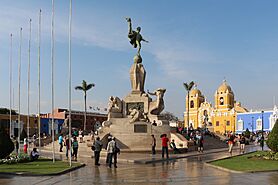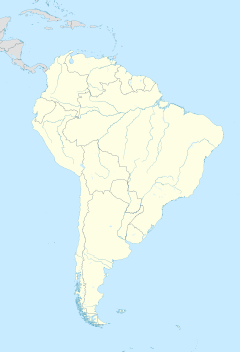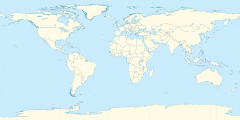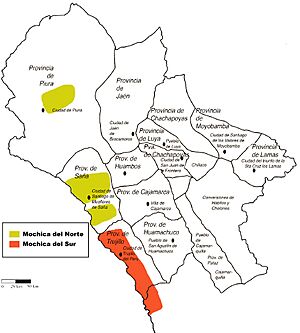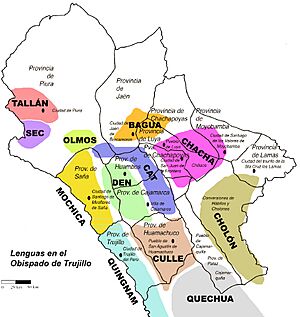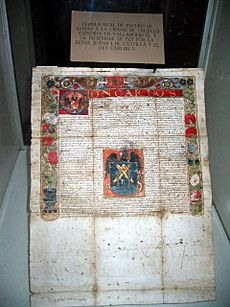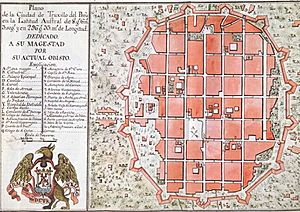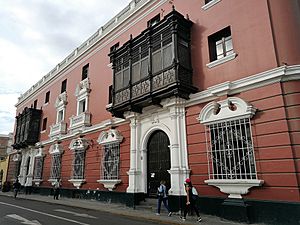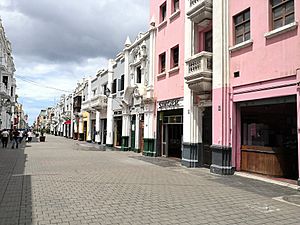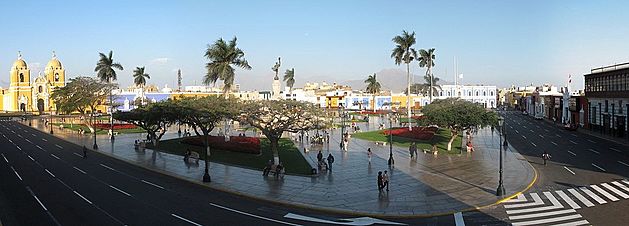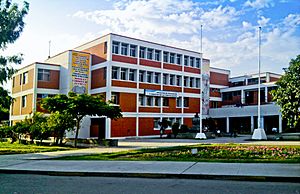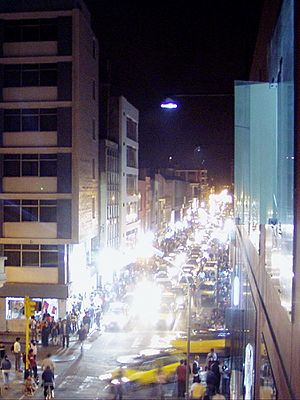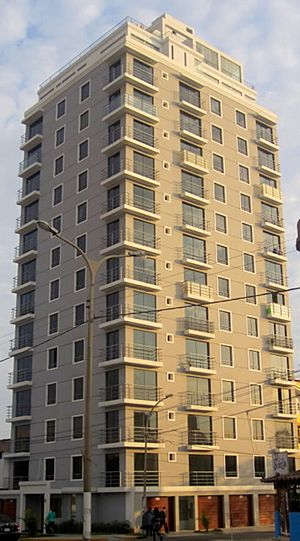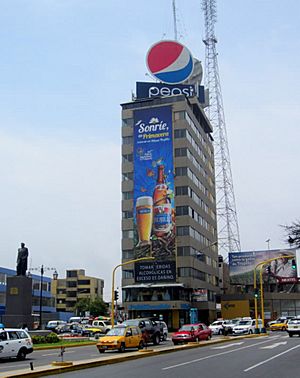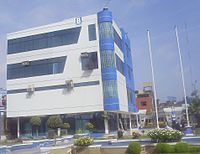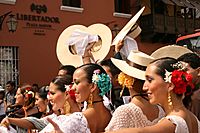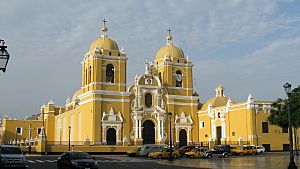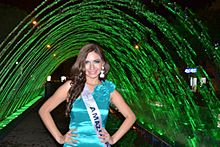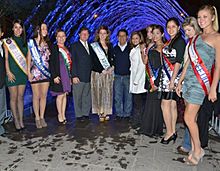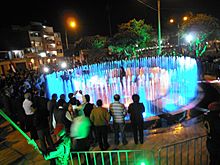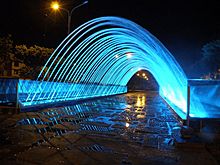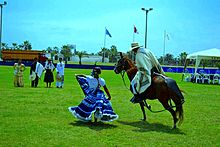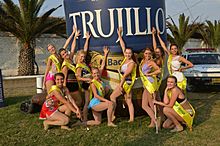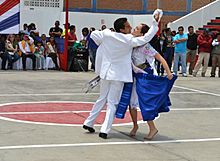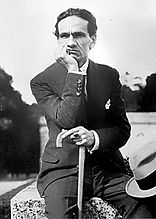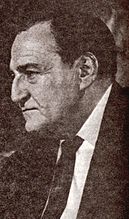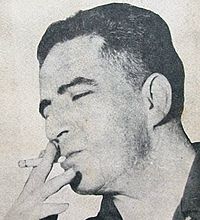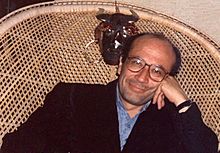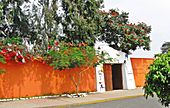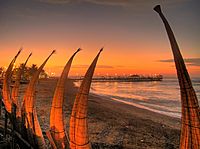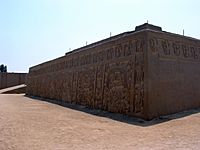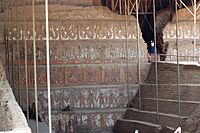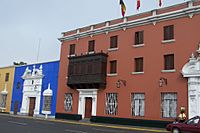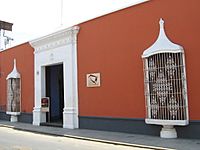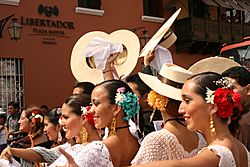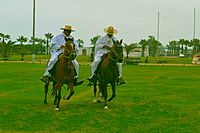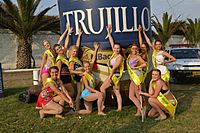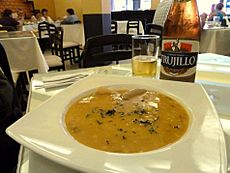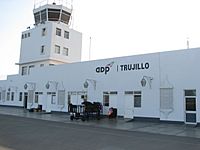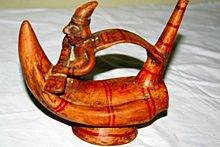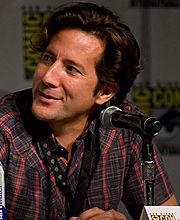Trujillo, Peru facts for kids
Quick facts for kids
Trujillo
|
|||
|---|---|---|---|
|
City
|
|||
| Trujillo de Nueva Castilla | |||
|
|||
| Nickname(s):
City of Everlasting Spring, Capital of Peruvian Culture, Capital of the Marinera, Meritorious City and Faithful to the Fatherland, Cradle of the Peruvian Paso, Cradle of Freedom, Cradle of the Peruvian Judiciary
|
|||
| Country | |||
| Department | La Libertad | ||
| Province | Trujillo | ||
| District | Trujillo | ||
| Founded | November 1534 | ||
| Founded by | Diego de Almagro | ||
| Named for | Trujillo, Spain | ||
| Government | |||
| • Type | Mayor–council government | ||
| Area | |||
| • Metro | 1,100 km2 (400 sq mi) | ||
| Elevation | 34 m (112 ft) | ||
| Population
(2017)
|
|||
| • Rank | 3rd | ||
| • Urban | 935,147 | ||
| • Metro | 962,369 | ||
| • Metro density | 874.9/km2 (2,266/sq mi) | ||
| Demonym(s) | Spanish: Trujillano/a | ||
| GDP (PPP, constant 2015 values) | |||
| • Year | 2023 | ||
| • Total | $10.5 billion | ||
| • Per capita | $11,600 | ||
| Time zone | UTC−5 (PET) | ||
| Postal code |
13001
|
||
| Area code(s) | 044 | ||
| Patron Saints | San Valentin Virgin of La Puerta |
||
| Metropolitan area | Trujillo Metropolitano | ||
| Integrated districts | Trujillo Victor Larco Huanchaco Moche La Esperanza Laredo El Porvenir Salaverry Florencia de Mora |
||
| Website | Municipality of Trujillo | ||
| Founded as Truxillo de Nueva Castilla (Trujillo of The New Castile)
Nearby places
|
|||
Trujillo is a city located on the coast of northwestern Peru. It is the capital of the Department of La Libertad. Trujillo is the third largest city and the center of the third largest metropolitan area in Peru. It sits by the Moche River, close to where it meets the Pacific Ocean, in the Moche Valley. This area was home to the ancient Moche and Chimu cultures long before the Inca Empire arrived and the Spanish took over.
Trujillo declared its freedom from Spain in its Historic Centre of Trujillo on December 29, 1820. In 1822, the Congress of the Republic of Peru honored the city with the title "Meritorious City and Faithful to the Fatherland" because of its important role in Peru's fight for independence. Trujillo is known as the birthplace of Peru's judiciary (its system of courts and judges). It was even the capital of the country two times! The city is also called the "City of Everlasting Spring" because of its pleasant weather. It is also known as the "Capital of the Marinera" (a traditional Peruvian dance) and the "Cradle of the Peruvian Paso horse." Trujillo is also called the "Capital of Culture of Peru." It hosts many national and international cultural events, like the "National Marinera Festival" and the Trujillo Spring Festival.
Close to Trujillo, you can find two major archeological sites with ancient monuments. One is Chan Chan, the biggest adobe (mud-brick) city in the ancient world. UNESCO named it a World Heritage Site in 1986. The other site has the Temples of the Sun and Moon, which include the largest adobe pyramid in Peru. The city center has many beautiful buildings from the colonial era, often with detailed wrought iron designs.
Since 2011, Trujillo has been part of a special project called Trujillo: Sustainable City. This project aims to make the city more environmentally friendly and better for its people. In 2012, IBM also chose Trujillo for a "Smarter Cities Challenge" project. This project uses technology to make public safety and transportation better.
Contents
- Understanding Trujillo's Identity
- Exploring Trujillo's Past
- Trujillo's Geography
- Trujillo's Population
- Trujillo's Economy
- Discovering Trujillo: Tourism
- Trujillo's Culture
- Transportation in Trujillo
- Media and Communication
- Sports in Trujillo
- Parks and Green Spaces
- City Services
- Famous People from Trujillo
- Sister Cities
- See also
Understanding Trujillo's Identity
Why is Trujillo the Capital of Culture?
Trujillo is known as the "Capital of Culture of Peru" for several reasons. Famous writers like Cesar Vallejo and Víctor Raúl Haya de la Torre are connected to the city. It is also a center for important cultural traditions. These include the marinera dance, Peruvian paso horses, and caballitos de totora (small reed boats). The city also has its own special food. The North Group, a famous group of writers and artists, was formed here. Trujillo hosts big national festivals, such as the Marinera Festival and the Spring Festival. There are also competitions for the paso horse and caballito de totora.
What are Trujillo's Symbols?
The City's Coat of Arms
The coat of arms was given to the city on December 7, 1537. This was by a special order from King Charles V of Spain. The shield shows two columns rising from water. A king's crown sits on top, surrounded by pearls and jewels. Two staffs are around the letter K, which stands for Karolus (King Charles). Behind the shield is a black griffin (a mythical creature) facing right.
The City's Flag
The flag of Trujillo shows the city's coat of arms on a white background. It is carried during official events by the Municipality of Trujillo in the main square. The flag is also flown every December 29. This day remembers the proclamation of Trujillo's independence in 1820.
The City's Anthem
The city's anthem was written by Ramiro Mendoza Sánchez. The music was composed by Ramiro Herrera Orbegoso. It is mainly played by bands during official city ceremonies.
Exploring Trujillo's Past
The history of Trujillo began a very long time ago. The area around the Moche River was a major center for many ancient cultures before the Europeans arrived. These cultures spread their influence along Peru's northern coast.
Ancient Cultures of Trujillo
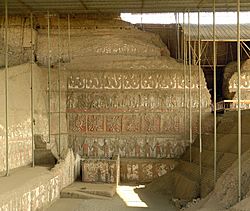
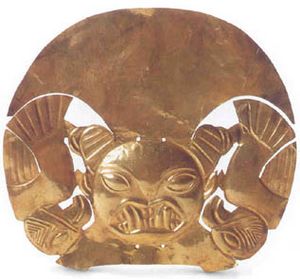
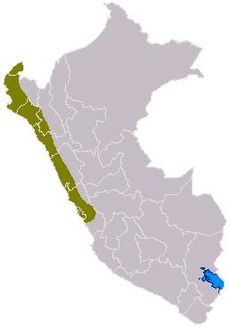
The archaeological history of this region goes back to very early times. For example, Huaca Prieta was used as early as 4700 BC. Several ancient cultures grew in this area. These include the Cupisnique, the Moche, and the Chimu. Many archaeological sites and large ruins show how complex these civilizations were.
Some Cupisnique culture sites are Caballo Muerto and Huaca Prieta. Moche culture sites include the huacas (ancient temples). These are the Temples of the Sun and Moon south of the city. Also, the Huaca del Dragón (or Rainbow Huaca) and the Huaca Esmeralda are to the north.
The Chimu culture built its main city at Chan Chan. This was their capital city and had about 100,000 people at its peak. It is the largest pre-Columbian city built from adobe (mud-brick). UNESCO has named it a World Heritage Site. Its ruins are about 5 km (3 miles) northwest of the current city center. The modern city of Trujillo was founded by the Spanish in an area already settled by these ancient people.
The Moche Civilization
The Southern Moche civilization thrived in northern Peru from about AD 100 to 800. They are known for their beautiful painted ceramics, gold work, and large buildings called huacas. They also built amazing irrigation systems to water their crops. Moche society was based on farming. Their leaders built many canals to bring river water to their fields. Their art shows scenes of hunting, fishing, fighting, and special ceremonies.
The Chimu Empire
The Chimu people built their empire called Chimor. Its capital was the city of Chan Chan, a huge adobe city in the Valley of Moche. The Chimu culture began around 900 AD and lasted until the 14th century. The Chimu spoke the Quingnam language.
The Inca ruler Tupac Inca Yupanqui conquered the Chimu around 1470. This happened only 50 years before the Spanish arrived. So, Spanish writers learned about the Chimu culture from people who remembered life before the Inca conquest. Chimu pottery was all black. Their metalwork was very detailed and complex. About 12,000 artisans lived and worked in Chan Chan. They fished, farmed, made crafts, and traded.
In 2018, archaeologists found the world's largest child-sacrifice site near Trujillo. They discovered the remains of over 140 children and llama skeletons.
Colonial Times in Trujillo
How Trujillo was Founded by the Spanish
Trujillo was one of the first cities in the Americas founded by the Spanish conquistadors. They arrived in an area that had been lived in and developed for thousands of years by local people. In November 1534, the explorer Diego de Almagro founded the first settlement. He named it Trujillo of New Castile after his hometown in Spain. It was built near four Chimu settlements to form an alliance against the Incas.
On November 23, 1537, King Charles I of Spain gave the town the title of 'city'. He also gave it the coat of arms that is still a symbol today. It was the first city in Peru to get a coat of arms from the king. By 1544, Trujillo had about 300 homes and 1,000 people. Its economy grew with farming sugar cane, wheat, and other crops, and raising animals.
Spanish colonists welcomed many religious groups. Many churches were built in the city during the 16th and 17th centuries. In 1577, Pope Gregory XIII created the Diocese of Trujillo. Construction on the cathedral began in 1616.
On February 14, 1619, a big earthquake hit Trujillo. It destroyed almost the entire city and killed about 400 people. Rebuilding was slow. People started to honor Saint Valentine because the earthquake happened on his day. The Jesuits opened a seminary and school to train priests. They also worked as missionaries, teaching Christianity to the local people.
The Wall of Trujillo
Because the city was close to the sea, it was in danger of attacks from pirates. So, the Wall of Trujillo was built for defense. An Italian architect, Giuseppe Formento, started building it on February 19, 1687. He based his design on a plan by Leonardo da Vinci for the city of Florence in Italy. The wall was built in an oval shape to save money. It was finished in 1689. The wall was about 5.5 km (3.4 miles) long and used over 100,000 bricks. It had 15 strong points and 5 gates.
The Huamán Gate faced west towards the village of Huamán. The Mansiche Gate was to the north, leading to the highway. The Miraflores Gate opened to the east. The Sierra Gate was named after the road to the mountains. Finally, the Moche Gate allowed people from the south to enter. In 1942, the city made a new plan. They built Avenida España along the path of the old wall. This road now circles the area called the Historic Center of Trujillo.
In the late 1600s, severe droughts and diseases caused a big economic problem for the city. Trujillo depended on farming. The city became important again in the 1700s. This was partly because the city of Saña was destroyed by floods in 1720. Trujillo also suffered from floods in 1701, 1720, 1728, and 1814. Earthquakes hit in 1725 and 1759. By 1760, about 9,200 people lived near the city. The start of the Municipality of Trujillo in 1779 happened when the city was doing very well. Trujillo was seen as one of the most important cities in Northern Peru during the colonial period.
Trujillo's Independence
Trujillo became a main center for Peruvian ideas of freedom. On December 29, 1820, the city declared its independence from Spain. This was led by the city mayor, José Bernardo de Tagle. Between 1821 and 1825, the Trujillo region was the only stable and productive area in the new country. In 1823, Trujillo became the first capital city of the Republic of Peru. On July 19, 1823, the Peruvian Congress, located here, asked Simón Bolívar to join the war for independence. In 1824, Bolívar's army arrived, and Trujillo was again made the seat of government. It is the only city to have been the capital twice.
After the revolution, the city's economy grew. The Moche and Chicama valleys became important for the sugar cane industry. Land was increasingly owned by large estates. A new group of rich farmers developed, who had influence in national politics. Free trade and foreign investment brought many Europeans, mainly from Britain and Germany. By then, Trujillo had 15,000 people and started to grow beyond its city walls. New building styles were adopted, influenced by French and English Romanticism.
During the War of the Pacific against Chile (1879-1883), Trujillo sent troops to defend the country. Although no battles were fought in Trujillo, Chilean troops occupied the city and took resources from the surrounding countryside.
The First Independent City of Peru
Trujillo is called the "First Independent City of Peru" for three main reasons:
- It declared independence from Spain on December 24, 1820, at the "Casa de la Emancipación" (House of Emancipation).
- Its leaders signed the declaration of independence at the Seminario de San Carlos y San Marcelo.
- They announced independence to a public meeting in the Plaza de Armas on December 29, 1820.
- On January 6, 1821, its leaders confirmed the agreement and the declaration of independence. This is recorded in the "Libro rojo" (Red Book) of the Trujillo council.
These actions helped almost all of northern Peru gain independence. The government of Trujillo city ruled what are now the regions of Tumbes, Piura, Lambayeque, La Libertad, Cajamarca, San Martín, and Amazonas. Marquis of Torre Tagle said, "My people. From this time for the unanimous will of the people, Trujillo is free. I put our fate and that of people under the protection of Heaven! Long live the homeland! Long live independence!"
Modern Trujillo: Republican Era
In 1821, General San Martín created the Department of Trujillo, based on the old colonial system. This was confirmed in Peru's first Constitution in 1823. Because of its size and wealth, the Department of Trujillo was the only stable and productive area that could lead the new country between 1821 and 1825. It covered almost half of Peru. For its efforts in the fight for freedom, San Martín gave it the title "Meritorious City Loyal to the Homeland." The city's council, then called a cabildo, was given the rank of "honorable."
In 1823, after Peru became a republic, the first President, Don José de la Riva Agüero, named Trujillo as the temporary capital. This was for a short time before royal troops took Lima. In 1824, the city welcomed the army of Simón Bolívar. He set up a temporary government in Trujillo on March 8, 1824.
In 1821, the Court of Appeals was created. Its power extended over what are now the departments of Cajamarca, Piura, Lambayeque, Amazonas, and Huamachuco. On March 26, 1824, Simón Bolívar created Trujillo's first Superior Court of Justice. It was the first high court in Peru with powers like the Supreme Court.
Trujillo in the 19th Century
By the late 1800s, the five entrances to the city had disappeared. The Wall of Trujillo was torn down, allowing the city to grow. New neighborhoods like Chicago, La Unión, and Pedro Muñiz were built. During the time of Mayor Don Víctor Larco Herrera, the city began improvements. These included building City Hall and making the Plaza de Armas more beautiful. A road was also built to the resort of Buenos Aires, which helped the city's planning. The Municipal Theater was also renovated.
Trujillo in the 20th Century
In July 1932, Trujillo was again at the center of an important event in Peru's history. This was the Trujillo Revolution of 1932. It was a difficult time for the city. This event shaped the city's political identity for the rest of the 20th century.
In the second half of the 20th century, the city grew a lot. Many people moved from rural areas to the city. Surrounding districts joined to form the Trujillo metropolitan area. By the 1980s, the city and nearby districts had become one large urban area. The Trujillo metropolitan area included the districts of Trujillo, El Porvenir, and Florencia de Mora. Víctor Larco Herrera and La Esperanza were still separate. In 1981, the city had 403,337 people. Also in the 1980s, the Trujillo Industrial Park project began in the La Esperanza district.
In the 1990s, Trujillo connected with the districts of La Esperanza and Victor Larco Herrera. The city's growth also included the districts of Moche, Trujillo, Salaverry, and Laredo as part of the metropolitan area. By the mid-1990s, Trujillo became a new major city in Peru. It had a population of 589,314 people.
Trujillo in the 21st Century
Modernizing the City
To manage the city's growth, the Provincial Municipality of Trujillo created the Trujillo Metropolitan Development Plan 2010 ("Plandemetru"). This plan, approved in 1995, guided the city's growth until 2010. Later, the "Strategic Plan for Integral Development and Sustainable Trujillo till 2015" set new guidelines.
A Sustainable and Smart City
In November 2010, Trujillo was the first city in Latin America and the Caribbean chosen by the Inter-American Development Bank (IDB). It was part of a pilot "Sustainable City" project. This project includes a plan for climate change, focusing on reducing emissions and checking investments for climate sustainability. According to an IDB representative, Trujillo was chosen to lead this new effort. The plan looks at financial health, environmental sustainability, and quality of life. The IDB works with the Municipality of Trujillo on these projects. In 2012, Trujillo also started a "Smart City" project with IBM. This project uses technology to improve public safety and transportation.
Trujillo's Geography
Where is Trujillo Located?
Trujillo is located 34 meters (112 feet) above sea level. It is on a coastal strip in the western part of Trujillo province. This area is the old valley of Chimor, now known as the Moche or Santa Catalina Valley. The main square is at 8°6′3″S 79°1′34″W / 8.10083°S 79.02611°W. The city is about 4.40 km (2.73 miles) inland from the Pacific Ocean.
What is Trujillo's Climate Like?
Trujillo has a desert climate and is known as La Ciudad de la Eterna Primavera (city of everlasting spring). This is because of its sunny and pleasant weather all year. The International Spring Festival in early October brings visitors from all over the world. The city has a mild climate with little rain. Temperatures usually stay between 14°C (57°F) and 30°C (86°F). This is due to the Humboldt Current.
Trujillo has warm days and mild nights because of the sea breeze. The average temperature is 18°C (64°F). The lowest and highest temperatures are usually between 17°C (63°F) and 28°C (82°F) in winter and summer. Rains are light and happen sometimes in the afternoon or evening. During the El Niño phenomenon, the climate changes. There is more rain, though less than in areas north of the city. Temperatures can also rise.
| Climate data for Trujillo (Capitán FAP Carlos Martínez de Pinillos International Airport) 1961–1990, extremes 1943–present | |||||||||||||
|---|---|---|---|---|---|---|---|---|---|---|---|---|---|
| Month | Jan | Feb | Mar | Apr | May | Jun | Jul | Aug | Sep | Oct | Nov | Dec | Year |
| Record high °C (°F) | 32.0 (89.6) |
35.0 (95.0) |
36.0 (96.8) |
35.0 (95.0) |
32.7 (90.9) |
30.0 (86.0) |
29.3 (84.7) |
27.0 (80.6) |
27.4 (81.3) |
30.5 (86.9) |
28.0 (82.4) |
29.5 (85.1) |
36.0 (96.8) |
| Mean daily maximum °C (°F) | 25.0 (77.0) |
26.0 (78.8) |
26.0 (78.8) |
24.5 (76.1) |
23.2 (73.8) |
22.0 (71.6) |
21.1 (70.0) |
20.4 (68.7) |
20.4 (68.7) |
20.9 (69.6) |
22.1 (71.8) |
23.5 (74.3) |
22.9 (73.2) |
| Daily mean °C (°F) | 21.0 (69.8) |
22.1 (71.8) |
22.0 (71.6) |
20.7 (69.3) |
19.1 (66.4) |
18.4 (65.1) |
17.8 (64.0) |
17.1 (62.8) |
16.8 (62.2) |
17.1 (62.8) |
18.0 (64.4) |
19.5 (67.1) |
19.1 (66.4) |
| Mean daily minimum °C (°F) | 16.9 (62.4) |
17.8 (64.0) |
18.0 (64.4) |
16.8 (62.2) |
15.7 (60.3) |
15.0 (59.0) |
14.4 (57.9) |
14.1 (57.4) |
14.0 (57.2) |
14.1 (57.4) |
14.6 (58.3) |
14.7 (58.5) |
15.5 (59.9) |
| Record low °C (°F) | 11.6 (52.9) |
9.8 (49.6) |
8.0 (46.4) |
11.1 (52.0) |
10.0 (50.0) |
7.0 (44.6) |
8.0 (46.4) |
8.0 (46.4) |
9.0 (48.2) |
8.0 (46.4) |
8.8 (47.8) |
11.0 (51.8) |
7.0 (44.6) |
| Average precipitation mm (inches) | 1.2 (0.05) |
0.8 (0.03) |
1.8 (0.07) |
0.1 (0.00) |
0.1 (0.00) |
0.0 (0.0) |
0.0 (0.0) |
0.0 (0.0) |
0.0 (0.0) |
0.2 (0.01) |
0.0 (0.0) |
0.1 (0.00) |
4.3 (0.17) |
| Average precipitation days (≥ 1.0 mm) | 1.3 | 0.6 | 0.9 | 0.6 | 0.0 | 0.0 | 0.0 | 0.0 | 0.0 | 0.0 | 0.1 | 0.4 | 3.9 |
| Average relative humidity (%) | 84 | 81 | 81 | 82 | 86 | 84 | 86 | 85 | 86 | 86 | 84 | 82 | 84 |
| Source 1: NOAA, Meteo Climat (record highs and lows) | |||||||||||||
| Source 2: Deutscher Wetterdienst (mean temperatures 1949–1985, precipitation days 1970–1990 and humidity 1975–1985) | |||||||||||||
Rivers and Land Features
The Moche River flows south of Trujillo. Its waters have been used since ancient times by the Moche and Chimu people to water their fields. Today, the river is part of the countryside of Moche and its waters are still used for farming. The river flows into the Pacific Ocean at the border between the districts of Moche and Víctor Larco Herrera.
Trujillo is located on a coastal plain in the La Libertad Region. It has gentle hills and sits on a plateau in the Trujillo Province. The lower parts of the city are very close to the Pacific Ocean. The higher parts are near the foothills of the Andes mountains.
Trujillo's Population
How Many People Live in Trujillo?
In 2007, the city of Trujillo had about 682,834 people. The population grew by about 2.1% each year. Another report from 2007 stated the population was 709,566. The city is made up of five districts: Trujillo, La Esperanza, El Porvenir, Florencia de Mora, and Victor Larco Herrera. It also includes a smaller area called "El Milagro" in the Huanchaco district.
The larger "Trujillo Metropolitano" includes these urban areas. It also has urban and rural towns from other districts like Huanchaco, Laredo, Moche, and Salaverry. In recent decades, Trujillo's growth is largely due to people moving there from other areas. Many come from provinces within La Libertad, like Otuzco, Santiago de Chuco, Ascope, and Sánchez Carrión. Others come from Cajamarca and Ancash.
- In the following table, you can see the population of Trujillo Metropolitan by district:
| Trujillo Metropolitan Area | |||||||
| Districts of Trujillo Metropolitan |
Data by Districts | ||||||
| Median elevation (msl) |
Distance (Approx.) to Historic Centre of Trujillo (km) |
Ubigeo | Area ([[km2]]) |
Density (inhabitants/km2) |
Population 2007 |
Population 2015 (Est.) |
|
| 1. Trujillo | 34 | 0 | 130101 | 39,36 | 7.035,5 | 294.899 | 318.914 |
| 2. Victor Larco Herrera | 3 | 5 | 130111 | 18,02 | 7.035,5 | 294.899 | 64.024 |
| 3. La Esperanza | 77 | 4 | 130105 | 18,64 | 7,8 | 151.845 | 182.494 |
| 4. El Porvenir | 90 | 4 | 130102 | 36,7 | 3.609,29 | 140.507 | 186.127 |
| 5. Huanchaco | 23 | 12 | 130104 | 333,9 | 114,2 | 44.806 | 68.104 |
| 6. Florencia de Mora | 85 | 5 | 130101 | 1,99 | 18.802,5 | 40.014 | 41.914 |
| 7. Laredo | 89 | 7 | 130106 | 335,44 | 96,17 | 32.825 | 35.289 |
| 8. Moche | 4 | 7 | 130107 | 25,25 | 1.146,7 | 29.727 | 34.503 |
| 9. Salaverry | 3 | 14 | 130109 | 390,55 | 33,67 | 13.892 | 18.129 |
| Trujillo Metropolitan | - | - | - | 110.000 | 837 | 804.296 | 949.498 |
| Sources INEI: Population 2007 Estimated population 2015 |
|||||||
- Graphics of the population.
- This chart compares the population of Trujillo city and the Trujillo metropolitan area. The green bars show the city's population growth. The blue bars show the population of Trujillo metropolitan. In 2014, Trujillo metropolitan was Peru's second largest metropolitan area with 935,147 people.
| Comparison Chart of Trujillo city and Trujillo metropolitan population |
|---|
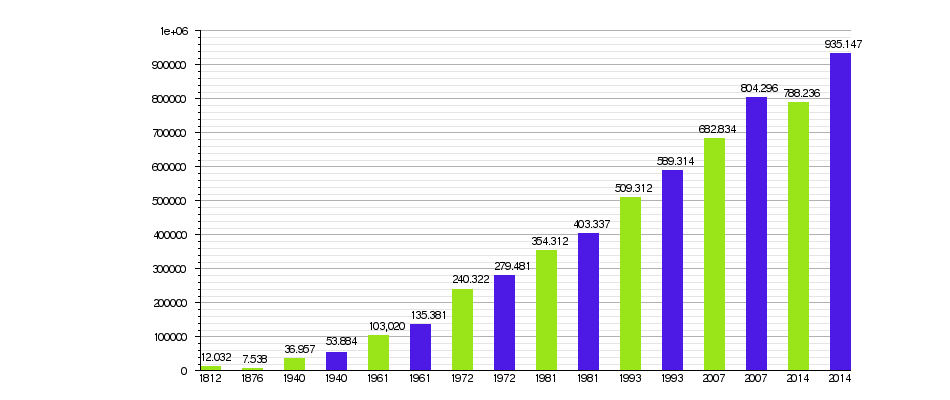 |
| Population of Trujillo city.
Population of Trujillo Metropolitan Sources: |
Religion in Trujillo
The main religion in Trujillo is Christianity, which came from Spanish culture during colonial times. There are different Christian groups in the city, like the Catholic Church, Jehovah's Witnesses, The Church of Jesus Christ of Latter-day Saints (LDS Church), and the Pentecostal Church. All these groups have their own places of worship. In the historic center, there are many Catholic churches, including the main cathedral in the Plaza de Armas.
One important Christian event in the city is Corpus Christi. It is organized by the Catholic Church each year and brings many Christians to the main square. According to the 2007 census, 76.9% of the population over 12 years old in Trujillo is Catholic. 15.1% are Protestant, 3.9% belong to other churches, and 4.1% are not connected to any church.
Trujillo's Economy
In the 19th century, Trujillo grew a lot because of its large farms. These farms produced a lot of sugarcane, which brought in high profits. Today, asparagus and shoes are some of the main products from its metropolitan area. The irrigated lands in the Moche River Valley grow sugarcane, rice, and asparagus. Industries in the city include sugar refineries, knitting mills, breweries, and shoe factories. Trujillo's asparagus is exported to nearby countries, Europe, and the United States. Peru is the world's top exporter of asparagus.
Trujillo is the most important economic center in northern Peru. It is a hub for trade and transport for the surrounding farming areas. With many shopping malls, supermarkets, and department stores, Trujillo is a modern city. In recent years, the construction industry has also become very important. Between 2006 and May 2012, construction in Trujillo grew by 500%. Most of this growth was in building homes.
Farming and Industry
Trujillo is a center for farming, trade, and transport. This is because of its productive agricultural areas. The growth of irrigated farming led to the city's expansion. This was especially true for the agribusiness of sugarcane.
One of its most popular products internationally is asparagus. It is mainly exported to neighboring countries, the USA, and Europe. The "Special Project Chavimochic" has helped a lot. This project irrigates the valleys of Chao, Viru, Moche, and later Chicama. It has led to successful exports of many farm products like artichokes, peppers, avocados, and mangoes.
Chavimochic Project
Chavimochic Special Project is a large hydraulic engineering project. This irrigation system covers much of the coast of the La Libertad Region in northern Peru. It is designed to water the valleys of Chao, Viru, Moche, and Chicama. By 2012, the project had advanced to its second stage in the Moche valley.
Leather and Footwear Industry
This industry includes shoe makers and other leather product manufacturers. It is part of the manufacturing sector. It has many small and medium-sized businesses (SMEs) that need a lot of workers and materials. There are 1,300 formally registered SMEs. They contribute 11% to the sector. They sell their products across Peru and make Trujillo known as a shoe-making city. Most of these businesses (53%) are in the El Porvenir district. Trujillo city itself has 24% of this activity. La Esperanza and Florencia de Mora each have 10%.
Commerce and Shopping
The city has the largest commercial activity in the region. This is driven by agribusiness, the footwear industry, metal engineering, and education. Some of the main shopping centers in the city are:
- Real Plaza
- Mall Aventura Plaza
- Open Plaza Los Jardines
- Penta Mall Mansiche
- Boulevard Primavera
- El Virrey
- Zona Franca
- Apiat
Local Brands from Trujillo
A 2010 study by Peru Económico magazine listed some of Trujillo's most important brands. These brands have a big impact on the region:
- Trujillo: A pilsener beer brand started in the early 1900s.
- Cassinelli: A beverage brand from the company Enrique Cassinelli and Sons SAC. They also make the Liber brand.
- Embutidos Razzeto: A meat and sausage company with one of the largest factories in Peru.
- Caja Trujillo: A major local financial company. It mainly helps small and medium businesses.
- Dulcería Castañeda: A traditional candy brand known for its "Alfajor Castañeda", formerly called Alfajor de Trujillo.
- GN: A brand of biscuits.
- Jano’s: A fast food brand in the city.
- UCV: The brand of a large group of universities. Its main campus is in Victor Larco district.
- Transportes Linea: A passenger transportation brand.
- Transportes Rodrigo Carranza (TRC): A heavy load transportation company. "TRC Express" offers passenger services. Its main base is south of the city in Moche district.
Discovering Trujillo: Tourism
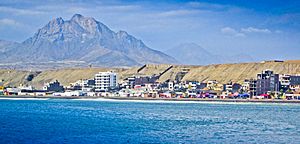
Tourism is a big industry in Trujillo. This is because the city is close to important sites where the Moche and Chimu civilizations lived. These ancient people were very skilled artists. Many of their artifacts have been found during archaeological digs in the city.
Nearby ruins include Chan Chan, the Chimu adobe city. It is the world's largest city built from mud-brick. It is sometimes called Ciudad de la Luna (City of the Moon) or de las Largas Murallas (of the Long Walls). Other nearby ruins are the Moche temples of Huaca del Sol, Huaca de la Luna, Huaca del Dragón o Arco Iris, Huaca Esmeralda, and El Brujo.
Trujillo hopes to be named a World Heritage Site. This is because of its ancient cultures and its historic colonial city center. The old mansions (casonas) in the city attract many visitors. Trujillo's wrought-iron window railings are a special feature of these mansions. The House of Ganoza-Chopitea (casa Ganoza) has a colorful front in the baroque style. It is topped with a rococo design and two lions. It is a great example of casonas architecture. Another is the House of Mayorazgo, built early in the city's history. It holds one of Peru's largest collections of old coins. The revolutionary leader Simón Bolívar lived in a house on the Plaza de Armas.
Huanchaco beach, a popular place for surfing, is just north of Trujillo. Trujillo's restaurants offer many local foods. These include shambar, often served on Mondays; ceviche; sopa teologa; and cabrito.
The Moche Route
The Moche Route is a tourist path that starts at the ancient capital of the Moche culture. This is at the Temples of the Sun and the Moon, about 4 miles (6 km) south of Trujillo's historic center. The route includes many places that were part of the Moche kingdom when it was powerful.
Top Tourist Attractions
Exploring the Historic Centre
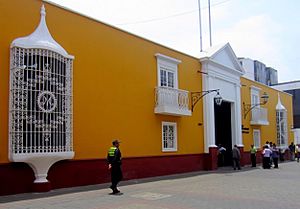
The historic center of Trujillo covers 133.5 hectares (330 acres). It has 1,783 lots grouped into 72 blocks. This area was once surrounded by the "Fence Trujillo" wall. Today, España Avenue borders the historic center. You can find many buildings from the colonial and republican periods here.
- Plaza de Armas (Main Square): This square is surrounded by the cathedral and beautiful colonial mansions. In the center is the Freedom Monument, which represents Peru's independence. The statue was made in France from marble and copper by sculptor Edmund Moeller.
- The Cathedral: Built between 1647 and 1666, its altars are in Baroque and Rococo styles. It has paintings from the Cuzco school and Quito school. The cathedral also has a museum with religious art from the colonial era, made of gold and silver.
- Casa del Mayorazgo or Casa Tinoco (Tinoco House): Built in the 16th century, this house is where the first flag of independence was designed in 1820. It is located at Jr. Pizarro 314.
- Casa Calonge or Urquiaga: Built in a neoclassical style between the 18th and 19th centuries. Simon Bolivar stayed here and planned much of his independence campaign. He also declared Trujillo the Capital of Peru and created the Superior Court of Justice from this house. You can see his desk and Chimu gold ornaments.
- Casa Ganoza: This house is famous for its "cover of the lions." Its Baroque design is topped with a Rococo pediment and two lions.
- Casa of Emancipation: This house was the headquarters of the First Constitutional Congress and the government house of President Jose de la Riva Agüero. Today, it hosts cultural exhibitions and is a traditional cultural center.
Amazing Archaeological Sites
- This is the largest pre-Columbian city in the Americas. It was built by the Chimu people. Located north of Trujillo, it is one of Peru's most impressive sites. UNESCO declared Chan Chan a World Heritage Site in 1986.
- These monuments are about 5 km (3 miles) south of Trujillo in the Moche district. This archaeological site was the capital of the Mochica culture from the 1st to the 9th century AD. The museum next to it is a popular tourist spot. The Temple of the Moon or Huaca de la Luna was a religious center for the Mochicas.
- This temple is located three blocks from the Mansiche temple. It is a rectangular building, about 65 by 41 meters (213 by 135 feet). It has two platforms. The first platform has Chimu decorations of fishing nets with fish. The second, older platform is similar to the Tschudi Palace, with designs of nets and sea otters.
- The Huaca del Dragon, also called Huaca del Arco Iris, is north of the city in the La Esperanza District, near Chan Chan. This is a large religious and ceremonial building made of adobe. Its walls are decorated with carvings showing human figures and rainbows.
- Huaca Takaynamo: This site is located in the La Esperanza district.
Caballito de Totora Boats
The making of boats called Caballito de totora is a long tradition at Huanchaco beach. Fishermen use these boats for their work. Tourists can also ride them for an adventure.
Fun Places Nearby
- Huanchaco is a traditional tourist spot in Trujillo. It is considered a World Surfing Reserve. Here you can see the reed boats called horses of totora, used for fishing since the time of the Chimu. The fishing harbor is also a famous landmark. Huanchaco is known as a great surfing spot and for its caballitos de totora. The most famous local food here is ceviche.
- Countryside of Moche
- The Moche district is crossed by the Moche River. It is home to the Temples of the Sun and the Moon, which were the capital of the Moche culture. In the countryside, you can try local dishes like soup theologian. The Moche countryside is rich in history and tradition.
- Lake Conache
- Lake Conache is in a large nature reserve in the village of Conache, in the Laredo district. It is about 9 hectares (22 acres) in size. The big dunes around it are perfect for sandboarding. A carob forest is also very close to the lagoon.
- Countryside of Simbal: This area is located in Simbal District.
- El Brujo: This is an archaeological complex about 45 km (28 miles) north of Trujillo. It is an ancient monument of the Moche culture. It includes Huaca Prieta (from pre-ceramic times) and the Moche temples of Huaca El Brujo and Huaca Cao Viejo. Huaca Cao Viejo is famous for its colorful carvings and wall paintings. It is also where the Dama de Cao, the first known female ruler in Peru, was discovered.
- Tourism in Trujillo city
Trujillo's Culture
Trujillo has always been a center of culture. Its traditions go back at least twelve thousand years. Ancient sites like the Temple of the Sun and Moon and the city of Chan Chan show this long history. Today, Trujillo is a modern cultural hub. It has universities, schools, and technology centers. These help the city develop new ideas and grow.
Education in Trujillo
Schools for Kids
The city has over 833 schools. Most of them (83%) are in the urban area, with half of those in the Trujillo district. Many secondary schools (53%) are in the Trujillo district, with more private schools. The growth of public schools and more private schools has helped more children get an education. Some important schools in Trujillo are:
- National College San Juan of Trujillo: In 1915, the poet César Vallejo taught first grade here to the novelist Ciro Alegría.
- Seminary College San Carlos and San Marcelo: This school has been educating students for over 386 years. It offers primary and secondary education for boys. It is considered a historic school in Peru.
- Great Unity School José Faustino Sánchez Carrión: This is one of the city's most important schools.
- College Santa Rosa: Located in the historic center of the city.
- College Rafael Narvaez Cadenillas: A pilot school that is part of the National University of Trujillo.
- Modelo College: One of Trujillo's flagship schools. It is located on the corner of Spain and El Ejército avenues.
- Max Ludwig Planck (School)
Universities in Trujillo
National University of Trujillo
Trujillo has many higher education institutions. These include most of the universities and vocational institutes in northern Peru. The most famous is the National University of Trujillo. It is one of the most important universities in Perú. It was founded on May 10, 1824, by Simon Bolivar. Famous people who studied here include:
- Poets: César Vallejo and Alejandro Romualdo.
- Political philosophers: Antenor Orrego.
- Political leaders: Víctor Raúl Haya de la Torre (APRA) and Luciano Castillo.
- Economists: Luis Alva, Pacific Huaman, Cesar Liza, Jaime Verastegui.
- Writers: Ciro Alegría and Eduardo Gonzalez Viaña.
- People related with National University of Trujillo (UNT)
-
Poet Cesar Vallejo
called by Thomas Merton "the greatest universal poet since Dante", studied at National University of Trujillo -
José Faustino Sánchez Carrión
considered by congress of his country the founder of Peruvian Republic, he also founded with Simon Bolivar the National University of Trujillo on May 10, 1824 -
Víctor Raúl Haya de la Torre
He is considered the most important Peruvian political leader of the 20th century, studied literature at UNT -
Ciro Alegría
journalist, politician, and novelist
Other well-known universities are Antenor Orrego Private University, Cesar Vallejo University, Catholic University of Trujillo, and Private University of the North. The Private University of the North is part of Laureate International Universities, making it one of two international universities in Peru. There are also the Private University of Trujillo, Leonardo Da Vinci University, Alas Peruanas University, and the archdiocesan seminary.
The city also has the Regional Conservatory of Music "Carlos Valderrama", which became a university in 2011.
Other Institutes
Some important technology institutes in the city are TECSUP, SENATI, SENCICO, Nueva Esperanza, Leonardo da Vinci, and Institute of the North. Trujillo also has the School of Arts Macedonio de la Torre, founded by painter Pedro Azabache Bustamante.
Museums and Art Spaces


- Museo del Juguete (Toy Museum): This unique museum is a few blocks from the Plaza de Armas. It belongs to the famous painter Gerardo Chávez. Here you can find toys from the mid-20th century.
- Museo de Arte Moderno (Museum of Modern Art): Another museum owned by Gerardo Chávez. It is located in the Semirustica El Bosque area. The museum shows works by famous national and international artists and sculptures. It is the first modern art museum in Peru.
- Museo Casa de la Emancipación (Emancipation House Museum): This house is considered a "Civic Sanctuary." Here, the Marquis Torre Tagle planned Trujillo's independence in 1820. It also hosted the First Constitutional Congress. Today, it holds cultural exhibitions and is a popular cultural center.
- Museo Huacas de Moche (Museum of Moche Temples): Located at the Huaca de la Luna in the Moche District. This modern museum opened in 2010. It displays recent archaeological discoveries from the Moche ceremonial center.
- Chan Chan Museum: This museum is located at the Chan Chan site. It displays important findings from the Chimu city and studies on its political and religious divisions.
- Trujillo's historic heritage
-
Muelle de Huanchaco
It shows the typical and ancient
caballitos de totora -
Typical balconies
Historical Center of Trujillo -
Museum House Haya de la Torre
Historical Center of Trujillo
Festivals and Events
Trujillo hosts many national and international festivals. Here are some regular events:
- Marinera Festival: This festival celebrates the traditional Marinera dance. The national competition is organized by the Club Libertad in the last week of January. Dancers from all over Peru and the world compete. The festival also includes a marinera parade with Peruvian paso horses and riders called chalanes.
- Trujillo Spring Festival (Spring International Festival): This is one of Peru's most important festivals. It happens in early October each year, organized by the Lions Club. The festival lasts a month and includes many activities. Highlights are the crowning of the Queen of Spring, paso horse competitions, and the Spring Corso parade.
- San Jose Festival: Held in Las Delicias in the Moche district on March 14, 15, and 16. This traditional festival has a strong Spanish influence. It includes activities for all ages, flamenco dancing, and a procession for Saint Joseph.
- Contest of Peruvian Paso Horse: Trujillo is known as the "cradle of Peruvian paso horse." Contests are organized by the Association of Breeders and Owners of Paso Horses. The most important ones are during the International Spring Festival (September-October) and the Marinera Festival (January). The Peruvian government has declared these horses a national cultural heritage.
- Trujillo Book Festival: In 2012, the 5th edition of this festival took place. It was organized by the Peruvian Chamber of Book during Trujillo's 477th anniversary. Over 100,000 visitors attended the "Plazuela El Recreo." There were 152 cultural and artistic events, including book presentations, poetry readings, and shows.
- Festival of Lyric Singing: This international festival happens every November. It is a competition for singers from many countries. It features international opera singers and pianists. It is organized by the Cultural Promotion Center of Trujillo at the Municipal Theater.
- Independence Day of Trujillo: Celebrated on December 29 each year. This day remembers the proclamation of Trujillo's independence in the Main Square in 1820. It is an official holiday with many cultural and artistic events.
- Carnival of Huanchaco
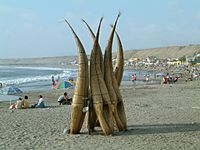
- This festival began in the early 20th century in the Huanchaco District. It was inspired by the famous Venetian Carnival. The carnival includes crowning a queen, surf contests, and a parade. It takes place in early February.
- Trujillo Ballet Festival: The international version started in 1977 at the Municipal Theatre. It features dance groups from many countries.
- Miss La Libertad: Every April, each province in the region sends a representative to compete for the 'Miss La Libertad' title. This event has been held in historic places like the Plaza de Armas and Chan Chan.
- Trujillo Anniversary Week: Celebrated in the first week of March. It remembers the installation of the first city council on March 5, 1535. The celebrations last about 5 days and include cultural events.
- Carnival of Conache: Held annually in the traditional town of Conache, in the Laredo District. It includes crowning a queen and a big celebration with the ancient drink called Chicha. This carnival is a traditional event that has been held since 1996.
- Lord of Huaman Festival: This religious festival takes place in the town of Santiago de Huamán. It is over 300 years old and attracts pilgrims and tourists. The celebration is from May 13 to 27, honoring the Lord of Huaman.
- Gastronomic festival of Trujillo: Also called Sabe a Perú. It celebrates Trujillo's famous dishes, like Moche pepper. It includes art shows, dances like marinera and tondero, and cooking contests.
Delicious Gastronomy
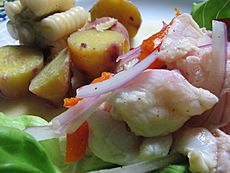
Trujillo's food is very tasty and varied. Many dishes have ancient traditions. They are made with fish, seafood, seaweed, birds, and farm animals. There are over a hundred traditional foods. The names of the dishes are often unique. With the rise of Peruvian food, many cooking schools have opened in the city.
Some of the most famous dishes include:
- Cebiche: Some historians say this dish started about 2000 years ago in the ancient Moche culture. It is made with fish fillet cut into pieces, lemon, onion, salt, and chili. Other ingredients like seafood or vegetables can be added. It is often served with sweet potatoes, corn, or cassava. The Peruvian government has declared this dish a National Cultural Heritage.
- Shambar: A soup made with beans and smoked ham. It is served with roasted corn. Restaurants traditionally serve it on Mondays.
- Theologian soup: A broth made with turkey or chicken, soaked bread, potatoes, milk, and cheese. It is traditionally prepared in the Moche district.
- Beans to the Trujillo: Black beans with sesame seeds and mirasol chili.
- Pepián of turkey: A turkey stew with rice, ground corn, cilantro, and chili.
- Trujillo fish: Steamed fish with eggs and onion sauce.
- Mollejitas to the sillao: A delicious dish served with onion salad and boiled yuca.
- The alfajores of Trujillo: Trujillo is known for making and eating sweets, especially traditional alfajores. The "Dulcería Castañeda" is a famous candy store that has made alfajores since 1925. Their "alfajor king kong" was once known as "Alfajor of Trujillo."
- Drinks: Famous local drinks include chicha of Moche, made from jora (sprouted corn), and chicha of Magdalena de Cao.
Music and Dance
The most important music and dance in Trujillo is the Marinera. The city is known as the Capital of Marinera. This dance is a national cultural heritage. Trujillo has many dance academies where people learn this traditional dance, often from a young age. Many participants from the city train for the national Marinera competition held every January.
Transportation in Trujillo
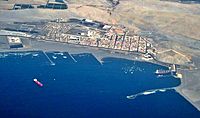
The city is connected to all major coastal cities by the Pan-American Highway.
- Trujillo International Airport: This airport is important for the city's transport. It is located in Huanchaco District, northwest of the Trujillo metropolitan area.
- Salaverry Port: The port town of Salaverry is southwest of Trujillo. It is one of Peru's busiest commercial ports. Salaverry port is about 258 nautical miles (478 km) north of Callao. Its good connections to Trujillo (12 km / 7.5 miles) and the Panamerican Highway (8 km / 5 miles) make it easy for businesses to use. This port is very active due to agricultural exports.
- Public Transportation: The Municipality of Trujillo estimates that about 29,285 passengers travel by bus out of Trujillo each week. About 28,580 passengers arrive weekly by bus. So, the municipality plans to build a new bus station. As part of the "Sustainable Cities" project, Trujillo is developing a "Plan of mobility." This plan includes Segregated cycle facilities (bike lanes), making the historic center pedestrian-friendly, building a green ring around España avenue, and possibly a Light rail system for the city.
Main Avenues
- Larco Avenue: One of the city's main avenues. It is named after the philanthropist Victor Larco Herrera. This road connects Trujillo and Víctor Larco districts. It starts in the west and runs to the Historic Centre of Trujillo. It has many shopping centers, schools, health centers, and government offices.
- España Avenue
- America Avenue
- César Vallejo Avenue
- Nicolás de Piérola Avenida
- Mansiche Avenue
Media and Communication
Trujillo has almost all types of communication services. These range from public telephones and internet cafes to wireless networks. Trujillo is a hub for media in the La Libertad Region. This includes television, radio, newspapers, and internet services. There are also mail and courier companies for local, national, and international services.
Newspapers
Some newspapers published in Trujillo are La Industria, which has a large circulation. Other newspapers include Nuevo Norte and the evening newspaper Satélite.
Telecommunication
Television Channels
Trujillo is home to several television channels. Some of these channels are also available in other cities in the northern region.
| TV stations in Trujillo city | |||||
|---|---|---|---|---|---|
| Name | Channel | Name | Channel | ||
| UCV Satelital | 15 | Antena Norte | 35 | ||
| Ozono TV | 41 | TV Mundo | 27 | ||
| Frecuencia TV | 55 | SOL TV | 21 | ||
| CTV Televisión | 45 | UPAO TV | 39 | ||
Radio Stations
Several radio stations broadcast from Trujillo on both AM and FM frequencies. Here are some FM stations:
| Radio stations in Trujillo city | |||
|---|---|---|---|
| FM Radios | |||
| Radio | MHz | Radio | MHz |
| Radio Nova | 105.1 MHz | Frecuencia 100 | 101.9 MHz |
| Stereo Diplomat Radio | 92.1 MHz | 96 Bravaza | 96.1 MHz |
| Ozono Radio | 104.1 MHz | Radio La Grande | 99.1 MHz |
| Radio Rumba | 99.9 MHz | PeruFolkRadio | |
| Radio Boulevard | |||
Sports in Trujillo
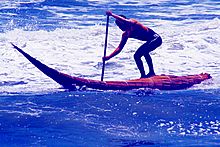
Some popular sports in Trujillo are volleyball, basketball, swimming, karate, and surfing. Surfing is mostly practiced at Huanchaco beach. Sandboarding is also popular. The most popular sport in Trujillo is soccer. The city has two teams in the Peruvian first division: Carlos A. Mannucci and Cesar Vallejo University. The main stadium for soccer is estadio Mansiche. The main venue for volleyball is the coliseo Gran Chimu. Both are located in the Sports complex Mansiche.
Basketball is also growing in popularity. The BCT (Basketball Club Trujillo) and UCV (Universidad Cesar Vallejo) teams have reached the semifinals of the national basketball club tournament. Trujillo's basketball clubs have been improving their level in recent years.
Sporting Events
- Half Marathon La Industria: On November 25, 2012, the 43rd edition of this event was held. The main race is 21.098 km (13.1 miles) long and runs through the city's main avenues. It is organized by the newspaper La Industria.
- Huanchaco Longboard World Championship: This surfing competition has taken place since 2010 at El Elio Beach in Huanchaco. It brings together top surfers from many countries.
- Copa Ciudad de Trujillo: This is an international football competition hosted in Trujillo since 2010. It features Trujillo's main team, Universidad César Vallejo, and guest teams from other countries. All matches are played at the Estadio Mansiche.
2013 Bolivarian Games
The Trujillo 2013 Bolivarian Games were a major international multi-sport event. They were held from November 16–30, 2013, in Trujillo. The Bolivarian Sports Organization (ODEBO) checked Trujillo's facilities in early 2011. They found that Trujillo had good conditions to host the games. So, the city was confirmed as the host on February 7, 2011. About 5,000 athletes from 11 or 12 nations competed in 36 sports.
Parks and Green Spaces
- The Mansiche Alameda: Located at the historic "old entrance of Mansiche," which was part of the ancient city wall. This area has many old trees and hosts cultural events.
- Trujillo Botanical Garden: Located on America Sur Avenue, south of the Historic Center. It has many different plants from the coast, Andes highlands, and jungle regions. It also has unique species like "pallar mochero" (a type of lima bean) and various cotton plants. Many birds live here, attracted by the diverse flowers.
- Swamps of Huanchaco
- Also known as Wetlands of Huanchaco, this is an ecological Chimu reserve at Huanchaco Beach. It is about 14 km (8.7 miles) northwest of Trujillo. Ancient Mochica people used reeds from these swamps to make their famous Caballitos de totora fishing boats. Today, Huanchaco fishermen still use materials from these swamps to build their boats.
City Services
Water, Sanitation, and Energy
The public company for water supply and sanitation in Trujillo and the La Libertad Region is SEDALIB. This company is owned by the municipalities of the region. For electricity, the company that provides power is called Hidrandina.
Famous People from Trujillo
- César Vallejo: A famous poet who lived in Trujillo from 1910 to 1917.
- Antenor Orrego: The first Peruvian political philosopher, who lived in Trujillo from 1910 to 1940.
- Víctor Raúl Haya de la Torre: A major political leader who founded the American Popular Revolutionary Alliance (APRA) in 1924.
- Maria Julia Mantilla: Miss Peru World 2004 and Miss World 2004.
- María José Lora: Miss Grand Peru 2017 and Miss Grand International 2017.
- Henry Ian Cusick: An Emmy-nominated actor born in Trujillo.
- Teodoro Rivero Ayllón: A writer and professor.
- Gerardo Chávez: A famous artist from Trujillo.
- Eduardo Gonzalez Viaña: A writer known for his novel "Vallejo en los Infiernos."
- Pedro Azabache Bustamante: An Indigenist and Costumbrist painter who founded the School of fine arts Macedonio de La Torre in Trujillo.
- Gerardo Privat Dextre: A fashion designer.
- Carlos Valderrama Herrera: A musician.
- Victor Larco Herrera: A politician and philanthropist.
- Víctor Felipe Calderón Valeriano: A master of marinera dance.
- Christian Cueva: A Peruvian footballer.
- José Carlos Fernández (Peruvian footballer): A Peruvian footballer.
- Envy Peru: Winner of Drag Race Holland Season 1.
- Orlando Romero: A professional boxer and restaurateur.
Sister Cities
Trujillo has sister city relationships with several places around the world:
 Trujillo, Spain
Trujillo, Spain Salt Lake City, United States
Salt Lake City, United States Metepec, Mexico
Metepec, Mexico Decatur, United States
Decatur, United States Trujillo, Venezuela
Trujillo, Venezuela Timișoara, Romania
Timișoara, Romania Trujillo, Honduras
Trujillo, Honduras
|
See also
 In Spanish: Trujillo (Perú) para niños
In Spanish: Trujillo (Perú) para niños


